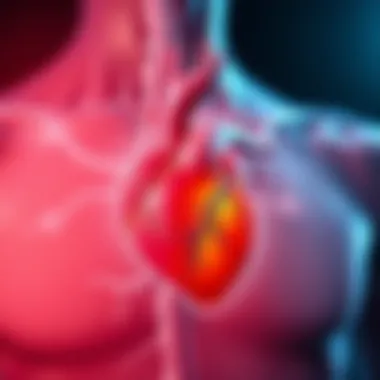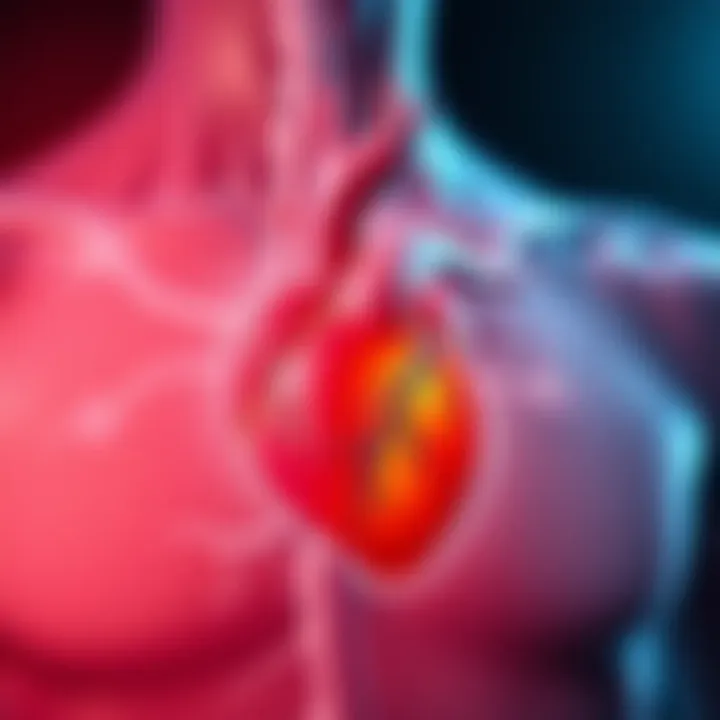The Link Between Heart Issues and Skin Conditions


Intro
Understanding the intricacies of the human body often requires piecing together complex connections. Among these, the relationship between heart health and skin conditions is particularly intriguing. Cardiovascular issues, while primarily linked to symptoms such as chest pain and shortness of breath, can also reflect through skin manifestations often overlooked.
This article delves into how skin rashes might serve as indicators of underlying heart problems. Through examining various skin conditions and their potential ties to cardiovascular health, we aim to shed light on an area that is both essential and often under-discussed—underscoring the importance of recognizing dermatological signs as a precursor to serious health evaluations.
The human body operates as a finely-tuned orchestra, where the heart plays a central role. When one instrument falters, it can create dissonance throughout the entire ensemble, including the skin, which is frequently regarded as a reflection of internal health. Therefore, grasping the nuances between skin rashes and heart issues could prove vital for health-conscious individuals, particularly for those in the fields of wellness, nutrition, and fitness.
To navigate this complex topic, we will cover the following key points:
- The physiological mechanisms that connect heart issues to skin conditions.
- A range of skin rashes that may indicate heart problems.
- Practical advice for assessing these symptoms and when to seek medical assistance.
Getting to the heart of the matter is crucial, not only for maintaining skin health but for our overall physical and mental well-being.
Understanding Cardiovascular Health
Understanding cardiovascular health is like peering into the very engine room of our bodies. It provides an essential backdrop to grasp how these systems interplay with other physiological aspects, particularly skin health. Adequate heart function is integral not just for circulation but also plays a vital role in overall bodily wellness. When the heart operates effectively, it pumps blood enriched with oxygen and nutrients throughout the body. If any part of this system falters, various issues can manifest, which may be reflected in other organs, including the skin.
The significance of cardiovascular health cannot be overstated. A sound cardiovascular system ensures efficient blood flow, which helps maintain skin elasticity and vitality. Furthermore, numerous conditions that affect the heart can lead to skin manifestations, making it crucial to comprehend the interconnections between heart and skin health. Whether it's through reduced blood flow causing pallor or skin rashes indicating an underlying issue, these signals can be subtle yet telling.
Fortifying cardiovascular health also brings a host of advantages: improved energy levels, enhanced immunity, and, beneficially, a healthier complexion. Understanding these connections helps individuals become more conscious of their health, prompting timely action leading to better health outcomes. The more well-versed one becomes in the workings of cardiovascular health, the better equipped they are to recognize changes and seek help when necessary.
By linking cardiovascular systems to skin conditions, we aim to create a more comprehensive understanding of health, demonstrating that monitoring one can be vital in caring for the other.
The Basics of Heart Function
The heart functions as a tirelessly working pump, orchestrating blood flow through the body. Through its cycles, it receives deoxygenated blood from the body, pumps it to the lungs for oxygenation, and then circulates it back to bodily tissues rich in oxygen. This cyclical process is integral for survival. A firm grasp on this mechanism is fundamental, as any disruption can lead to complications.
Common Heart Conditions
Coronary Artery Disease
Coronary Artery Disease (CAD) is one of the most prevalent forms of heart disease. What makes it particularly noteworthy in our discussion is its direct impact on blood flow to the heart muscle due to plaque buildup in the arteries. This restriction can lead to chest pain or heart attacks, and in some cases, may also lead to dermatological symptoms—rashes appearing due to poor circulation or even as side effects of medications used to treat the condition. Its high prevalence among populations offers a prime example of how heart issues can ripple into skin health.
Heart Arrhythmias
Heart Arrhythmias include a range of irregular heart rhythms. The unique aspect of these conditions lies in their unpredictability. This erratic heartbeat can lead to varying blood flow levels, which could generate problems elsewhere, such as causing skin pallor or even rashes. The connection is vital; thus recognizing arrhythmias opens the door to understanding broader physiological implications, including skin health.
Heart Failure
Heart Failure is a chronic condition where the heart can't pump blood efficiently. This inefficiency can cause fluid retention, leading to swelling not just in the legs or feet but could also impact the skin, causing rashes as the body reacts to imbalances in fluid distribution. Acknowledging heart failure's ramifications is critical for both cardiovascular integrity and skin observations.
Risk Factors for Heart Disease
Genetics
Genetics play a pivotal role in cardiovascular health. Family history can be a strong indicator of predisposition to heart problems. Variations in genes responsible for blood pressure regulation or cholesterol metabolism can trigger conditions that may affect skin health. The unique feature here is how these genetic indicators often manifest early; thus, proactive management can mitigate potential issues down the road.
Lifestyle Choices
Lifestyle Choices govern many aspects of heart health. Poor diet or lack of exercise marks the path to numerous heart conditions. These choices can lead to weight gain and increasing blood pressure, posing a risk to both heart health and skin vitality. When individuals opt for healthier diets rich in antioxidants, not only does heart health benefit, but skin elasticity and overall appearance tend to improve as well.
Environmental Influences
Environmental factors, such as pollution, can drastically affect heart health. Prolonged exposure to contaminants can lead to diseases like hypertension, which could, in turn, go unnoticed until skin issues arise, making this connection all the more relevant. The unique aspect of these influences is their omnipresence; being aware of them can spur changes to mitigate risks.
Preface to Skin Health


Understanding the connection between the heart and skin health is crucial for various reasons. The skin serves as a window to our overall well-being, often reflecting internal issues that may not be immediately apparent. In this article, we delve into the intricacies of skin function and various conditions that can emerge due to, or are exacerbated by, heart problems.
The Role of Skin in Overall Health
Skin is not merely a protective barrier; it's a dynamic organ that plays a significant role in maintaining bodily homeostasis. When the heart isn't functioning optimally, it can manifest itself through skin changes. The skin's ability to respond to internal stressors makes it an essential indicator of cardiovascular health. For instance, alterations in blood flow due to heart issues can lead to changes like pallor or cyanosis, which are visible signs of poor circulation.
Common Skin Conditions
Many types of skin conditions can emerge from or be closely related to heart problems, often providing early warning signs of potential cardiovascular challenges. Addressing these skin issues not only helps improve overall health but can also prompt further investigations into heart health.
Eczema
Eczema is a chronic skin condition characterized by inflamed, itchy patches of skin. This condition highlights the importance of skin health in overall well-being. Eczema can be exacerbated by stress—a common byproduct of heart issues. Its key characteristic is the irritation that can lead to discomfort and scratching, further complicating the cycle of skin health. One unique aspect of eczema is its frequent association with allergies and asthma, conditions that don’t just affect the skin but also highlight the interconnectedness of various health systems.
Psoriasis
Another noteworthy skin condition is psoriasis. This autoimmune disorder results in rapid skin cell turnover, leading to thickened, red patches covered with silvery scales. Psoriasis can have systemic implications, often indicating a link to metabolic syndrome, which is a risk factor for heart disease. Its significance in this article lies in its portrayal as a visible manifestation of systemic inflammation affecting multiple body systems.
Hives
Hives, or urticaria, represent another skin condition worth mentioning. These welts can appear suddenly and are often a response to allergens or stress, pointing to potential underlying health issues. The itchy welts serve as a reminder that skin reactions often signal that something not quite right is happening in the body. In the context of heart health, severe stress or allergic reactions can be directly linked to cardiovascular strain.
The Skin-Body Connection
Severe Illness Indicators
Severe illness indicators can show up in various skin changes. For example, conditions like petechiae or purpura, little red or purple spots on the skin due to bleeding under the skin, can indicate serious cardiovascular issues. Recognizing these signs is crucial as they can help prompt timely medical evaluations. The unique feature here is how these indicators serve as visual signals for conditions that need urgent attention.
Disruption of Homeostasis
Disruption of homeostasis refers to the body’s failure to maintain stable internal conditions. Skin conditions such as excessive dryness or excessive oil production can indicate imbalances that relate back to cardiovascular function. The skin's response is often a reflection of more systemic problems. The unique aspect of this is how the skin can show early warning signs of life-threatening conditions that might could have been easily missed.
Understanding the relationship between the skin and heart provides an overall view of health that goes beyond symptoms, allowing for a thorough examination of well-being.
The Relationship Between Heart Problems and Skin Rashes
The connection between cardiovascular health and skin conditions may not be the first thing that springs to mind. However, understanding how heart issues can manifest through skin problems is crucial. This topic sheds light on the interdependent nature of bodily systems, highlighting a unique area where dermatological symptoms may signal underlying cardiovascular concerns. Recognizing these signs early can make a significant difference in preventive health and treatment outcomes.
Possible Mechanisms of Interaction
Blood Flow Issues
When we talk about blood flow issues, it’s about how effectively blood circulates through the body. This circulation is vital for maintaining skin health. Reduced blood flow, often caused by heart issues, can lead to a range of skin problems. It starves the skin of necessary nutrients and oxygen, which in turn disrupts its natural healing processes. One key characteristic of poor blood flow is its ability to create a pallor or even a bluish tint on the skin. This is particularly crucial for our overarching discussion, as it underlines the body's immediate response to cardiovascular strain. The unique feature of blood flow issues is that they can be reversible with appropriate heart management. However, prolonged neglect can lead to continued skin deterioration, making this an essential area to explore in our discussion of cardiovascular health.
Inflammatory Responses
Inflammatory responses are natural mechanisms that the body employs to fight infections and heal injuries. However, when the cardiovascular system is compromised, chronic inflammation can ensue, leading to skin rashes and other dermatological issues. In this context, inflammation can lead to conditions like eczema or psoriasis—rashes that many may brush off as mere skin irritations when they might actually indicate something more serious. The hallmark of inflammatory responses is their propensity to cause redness, swelling, and discomfort. Because they emerge from complex interactions within the body, understanding this relationship offers clarity on how skin can reflect heart health. Additionally, the treatment for inflamed skin often involves addressing the inflammation itself rather than treating the skin alone, making this connection crucial for effective management.
Autoimmune Conditions
Autoimmune conditions occur when the body's immune system mistakenly attacks its own cells, and many of these conditions can link back to heart health concerns. For instance, lupus and other autoimmune diseases often exhibit skin rashes as a primary symptom, and their relationship with heart function can be intricate. A critical aspect of autoimmune conditions is their unpredictability; symptoms can flare up or stabilize at any time, making monitoring essential. This topic deserves attention because it highlights how immune dysregulation can impact both heart function and skin integrity. The unique feature with autoimmune diseases is that they require a multifaceted treatment approach, combining medications for both skin lesions and heart-related issues, thereby emphasizing the interconnected nature of health.
Types of Rashes Related to Heart Problems
Petechiae
Petechiae are small, flat red or purple spots that appear on the skin when tiny blood vessels break. They can indicate potential cardiovascular issues, such as clotting disorders or heart failure. One telling characteristic of petechiae is that they do not blanch or turn white when pressed, a signature trait that can alert medical professionals. Understanding this condition is crucial because it can act as an early warning sign of serious heart-related issues. The advantage of identifying petechiae lies in the prompt investigation it can trigger, potentially leading to life-saving interventions.
Purpura


Similar to petechiae, purpura involves larger areas of bleeding under the skin, giving a purple or brownish appearance. It's typically caused by what we call vascular fragility and can be linked to various heart conditions, such as thrombocytopenia or other clotting disorders. This condition is beneficial to recognize because it provides visible evidence of underlying vascular issues that may require urgent evaluation. An important feature of purpura is that its presence often prompts a deeper investigation into cardiovascular health, underscoring its role as a visible marker of severity.
Dermatitis
Dermatitis encompasses a wide range of inflammatory skin conditions that can arise from allergenic triggers or systemic issues, including heart problems. One of the key characteristics is that it can manifest in various forms such as atopic dermatitis, contact dermatitis, or even stasis dermatitis, the latter directly linked to poor venous circulation stemming from heart problems. Its significance in this article lies in the understanding that while dermatitis might seem isolated to the skin, it can also reflect internal health issues that warrant attention. The unique aspect of dermatitis is its treatment complexity; addressing the skin’s condition can often require holistic management, ensuring that both skin and cardiac health are taken into account.
Case Studies and Clinical Observations
Delving into case studies and clinical observations presents a real-world dimension to the interplay between heart problems and skin rashes. Notably, practitioners have documented instances where patients with known cardiovascular impairments presented with specific skin symptoms, prompting immediate evaluation.
For example, a patient exhibiting unexplained widespread purpura could, upon examination, be found to have undiagnosed heart conditions, reinforcing the idea that the skin often serves as a window to internal health. Clinical occurrences such as these underscore the necessity for healthcare providers to maintain a watchful eye on dermatological manifestations, as they can lead to the early detection and prevention of more severe heart problems.
Symptoms to Monitor
Monitoring symptoms that can arise from both heart problems and associated skin rashes is crucial for early detection and effective management. Many individuals, unfortunately, often overlook these signs, mistakenly thinking they are unrelated. However, recognizing these symptoms not only empowers patients but can also serve as a critical bridge connecting cardiovascular health and dermatological issues. It is essential to keep an eye out for specific indicators that might signify a more complex underlying condition.
Cardiovascular Symptoms
Chest Pain
Chest pain is a hallmark symptom that serves as a red flag for potential heart issues. It's crucial to take note of this symptom as it directly correlates with heart health. One of the key characteristics of chest pain is that it can manifest in various forms, from sharp and stabbing to a heavier, more constricting sensation. This symptom is particularly significant for this article due to its direct implications for understanding cardiovascular health.
The unique feature of chest pain is its ability to vary greatly among individuals. For some, it may feel like a tight band around the chest, while for others, it may mimic heartburn or indigestion. This variability can sometimes lead to misunderstandings or misdiagnoses. Recognizing chest pain as a common yet critical symptom aids in timely medical intervention, highlighting its importance in the broader picture of health monitoring.
Shortness of Breath
Another major cardiovascular symptom is shortness of breath. Often, this symptom accompanies exertion or stressful situations, but it's essential to recognize when it occurs at rest. The primary characteristic of shortness of breath is the feeling of not receiving adequate air, which can escalate into panic or anxiety.
In the context of this article, its relevance is twofold. Shortness of breath can signal an array of heart conditions, including heart failure or arrhythmias, making its recognition paramount. The unique aspect of this symptom is its capacity to indicate not just physical health but also emotional well-being. Its presence can complicate matters, as anxiety can worsen the sensation of shortness of breath, making it hard to discern the root cause — heart-related or otherwise.
Dizziness
Dizziness frequently emerges as a cardiovascular symptom linked to various heart issues. This sensation can be lightheadedness, a feeling of unsteadiness, or vertigo, where the room seems to spin. Dizziness stands out due to its elusive nature; it may catch people unaware and can often be mistaken for fatigue or dehydration.
In the grand scheme of this article, dizziness is beneficial as it can serve as a pivotal clue pointing towards problems with blood flow or pressure regulation within the heart. This symptom is often accompanied by two significant phenomena: first, its occurrence can lead to falls or mishaps, and second, it can be exacerbated by certain medications that manage heart conditions. Therefore, understanding the implications of dizziness can provide a deeper insight into comprehensive health monitoring.
Skin Rash Characteristics
Type of Rash
The examination of the type of rash is critical for understanding how skin issues may relate to heart problems. Different rashes signal various underlying conditions, and the characteristic appearance—be it raised, flat, red, or itchy—can help narrow down the diagnosis. Certain rashes, like petechiae or purpura, are directly tied to blood flow abnormalities that can stem from heart issues.
Identifying the type of rash is essential; for example, psoriasis or eczema may connect indirectly to stress or lifestyle choices influenced by heart health. The unique feature of this connection lies in the ability of dermatological symptoms to mirror systemic health and warn of internal disruptions.
Location of Rash
The location of the rash plays a pivotal role in diagnosis. Rashes that appear on areas with higher vascular activity, like the face or trunk, might signify deeper issues related to circulatory health. The location can give insight into whether the rash is inflammatory, allergic, or a vascular phenomenon related to heart conditions.
This aspect stands out because it allows medical professionals to correlate skin characteristics with cardiovascular symptoms. For instance, a rash on the lower extremities could relate to venous insufficiency, providing critical diagnostic clues that can guide further assessments.
Accompanying Symptoms
Lastly, accompanying symptoms linked with skin rashes can paint a broader picture of overall health. These additional indicators, which may include fever, fatigue, or changes in appetite, can signal an underlying systemic condition. This characteristic of associated symptoms highlights the interconnectedness of body functions, emphasizing their relevance.
Accompanying symptoms can serve as a beneficial diagnostic toolkit; when seen alongside a skin rash, they may point to more severe complications, enabling swift medical responses. Hence, closely monitoring these facets is advisable, recognizing that they hold valuable information regarding potential heart-related issues.
Monitoring symptoms is a vital step in safeguarding overall health; recognizing and acting on the body's signals can significantly impact treatment outcomes and quality of life.
When to Seek Medical Advice


Recognizing the signs that warrant medical attention can be crucial in managing both heart problems and skin rashes. Many individuals might shrug off seemingly benign symptoms, attributing them to stress or mild allergies. However, ignoring these indicators can lead to serious health consequences. This section underscores the importance of vigilance and awareness in monitoring one’s health. We’ll delve into what constitutes as warning signs and why appropriate medical evaluation is essential.
Recognizing Red Flags
Identifying symptoms that shouldn't be overlooked is the first step toward proactive health management. Here are some specific red flags to keep an eye on:
- Chest Pain: Whether it feels like a tightness, heaviness, or sharp pang, chest pain can be a sign of heart trouble.
- Changes in Skin Texture: If rashes evolve unexpectedly or have characteristics such as scaling or oozing, this could relate to underlying cardiovascular problems.
- Persistent Fatigue: Extreme tiredness without a clear explanation can indicate an issue with heart function.
- Unexplained Rashes: Skin eruptions that appear suddenly, especially in conjunction with other symptoms, should raise eyebrows. Petechiae or purpura, for example, may signal blood flow issues.
"Ignoring early warning signs can turn minor problems into major health threats. Listening to your body is key."
Importance of Timely Evaluation
If you find yourself experiencing any of the aforementioned symptoms, seeking medical advice promptly can drastically influence outcomes. Here's why:
- Early Detection of Heart Disease: Addressing cardiovascular issues early can prevent complications. Regular check-ups and relevant testing can uncover problems before they escalate.
- Linking Symptoms with Conditions: Understanding how skin rashes and cardiovascular health are interconnected can help doctors provide better care. For instance, rashes linked with autoimmune diseases may provide insights into heart health, allowing for a more tailored treatment approach.
- Psychological Well-being: The uncertainty surrounding unexplained symptoms can lead to anxiety. Getting a professional opinion can alleviate concerns and put your mind at ease.
In summary, while it’s natural to brush off minor symptoms, maintaining a proactive approach to your health by recognizing red flags and seeking timely evaluations is crucial for overall well-being. By staying informed and attentive, individuals can significantly enhance their chances of preventing serious health issues.
Prevention and Management Strategies
Both skin and heart health are interlinked, making prevention and management strategies vital in maintaining overall wellness. This section explores several facets of how to mitigate risks and optimize health outcomes, focusing on lifestyle adjustments and regular health monitoring.
Lifestyle Adjustments
Living a heart-healthy life can resonate through your skin's appearance and overall wellbeing. Just tweaking a few habits can have monumental impacts.
Balanced Diet
A Balanced Diet plays a critical role not just in heart health but also in skin condition. It emphasizes the importance of nutrients that support both cardiovascular and dermal systems. For instance, incorporating plenty of fruits, vegetables, wholesome grains, and healthy fats can bolster your skin’s glow and keep your heart ticking healthily.
This dietary approach is beneficial because it naturally provides antioxidants and essential fatty acids that reduce inflammation, a root cause of various skin issues. The unique feature of a balanced diet is its flexibility; it allows individuals to tailor their nutritional intake according to their specific needs and preferences. However, folks need to consider their personal health conditions—like cholesterol levels—that may restrict certain foods.
Regular Exercise
Regular Exercise is another essential element that aids both heart and skin health. Engaging in consistent physical activity not only strengthens the heart but also enhances blood circulation, delivering nutrients and oxygen to the skin. Many people find it empowering to establish a routine, whether that be brisk walking, cycling, or yoga, as it promotes a sense of accomplishment alongside physical health.
With its unique allure of being able to boost mood through the release of endorphins, regular exercise is often considered a two-for-one deal. Still, if someone is just starting out, it's crucial to listen to one's body and avoid pushing limits, as overexertion can lead to injuries.
Stress Management
Stress Management is possibly one of the most overlooked areas in health care discussions today. Chronic stress can contribute to heart problems and manifest in skin issues such as breakouts or eczema flare-ups. Utilizing techniques like mindfulness, meditation, or even simple breathing exercises can align one's focus and improve overall mental health.
What makes stress management unique is its accessibility. It can be practiced anywhere, at any time. Regular practice can establish a calmer state of mind, which, in turn, helps reduce cortisol levels that are often linked to heart disease. However, it does require commitment and may take time to find strategies that cater best to individual needs.
Monitoring and Regular Check-ups
Keeping track of one’s health through Monitoring and Regular Check-ups is paramount. Regular visits to healthcare professionals can help catch any underlying conditions early before they escalate.
Encouraging individuals to maintain a proactive approach toward their health may include devising a schedule for routine check-ins with their physician, dermatologist, or nutritionist, depending on their specific health requirements.
The importance of these strategies cannot be overstated. They empower individuals to take control of their health, paving the way for a future where both heart and skin thrive.
"An ounce of prevention is worth a pound of cure," a saying that rings especially true when considering the intricate bond between heart health and skin wellness.
Finale
In the intricate web of human health, the connection between cardiovascular issues and skin rashes serves as a poignant reminder of how interconnected our body systems truly are. This discussion emphasizes the significant role that skin conditions can play in signaling underlying heart problems, an aspect that often receives less attention despite its potential implications. By acknowledging these correlations, individuals can better navigate their health care decisions.
One of the critical elements gleaned from this exploration is that skin rashes like petechiae or purpura, often dismissed as mere irritations, can actually be indicators of something more severe, such as compromised blood circulation due to heart conditions. Meanwhile, understanding the mechanisms—be it inflammation or autoimmune responses—provides insights into prevention and management, urging individuals to regard skin health as a vital part of overall well-being.
Moreover, early symptoms indicating heart issues, which may manifest as dermatological symptoms, underscore the importance of maintaining vigilance. These early warning signs can be integrated into routine health evaluations, potentially leading to timely interventions that could avert serious health consequences.
Overall, taking these connections into account encourages a more proactive approach to personal health management. Individuals should consider routine cardiovascular screenings, not just when heart problems seem apparent but also when witnessing unexplained skin changes.
"The skin is not just a barrier; it reflects our overall health status, making careful observation key."













